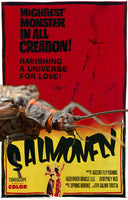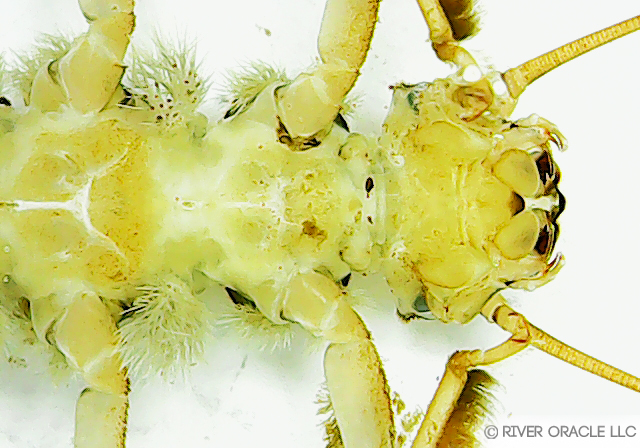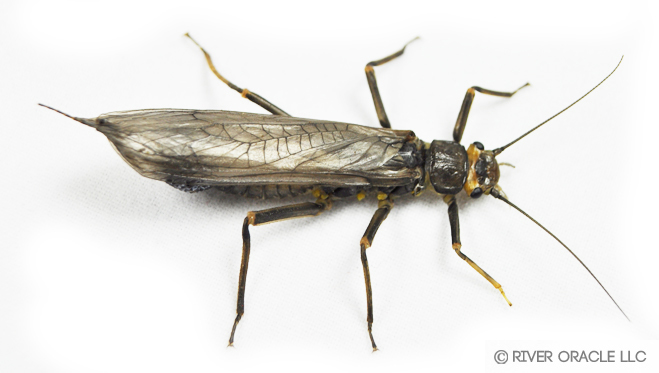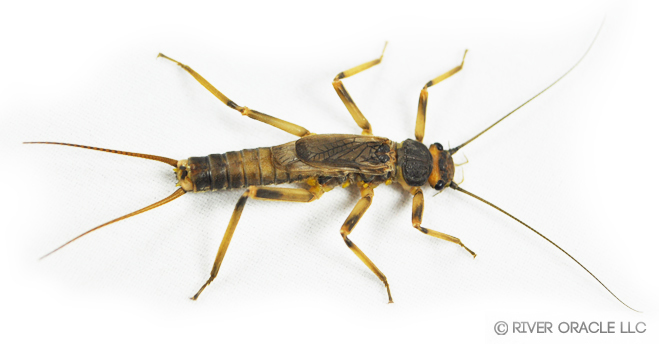
A Fly Fisher's Guide to Identifying and Matching Stoneflies: Part I

A morning mist swirled over the surface of the water just as it had thousands of times before, but this morning was destined to be different than those that had proceeded it. Breaking through the dark surface of the water emerged two long antennas followed by a head that one would expect to see in prehistoric times and not in a peaceful mountain stream. Long legs tipped with sharply-hooked claws sought purchase on stone as it pulled its massive bulk from the grip of the river's current. Basking in the first rays of the dawn, it body begins to shudder and shake before its back is ripped asunder! Climbing from the shattered remains of its back emerge four membranous wings that beat at the air, buffeting the landscape with wind. The stonefly, mightiest of all aquatic invertebrates, rises in its full glory and takes to the air!
Among the largest aquatic invertebrates and the most eagerly anticipated by anglers and trout alike is the stonefly. Comprised of 10 families and 465 species spread throughout the streams and rivers of North America, this trout favorite emerges in all four seasons, as opposed to Caddis and Mayflies which only emerge spring through fall. Dwarfing the midges, mayflies, and caddisflies that share the water with them, stoneflies are like T-Bone steaks to a trout and can produce explosive strikes from calorie-starved fish. While sharing many characteristics with mayflies during the nymph life cycle, here are the family characteristics that will enable you to distinguish the two and match this incredible family.
The Stonefly Nymph
Accounting for 99.9% of the life of the stonefly, the nymph life cycle (for most species) will last between 1 to 3 years. Primarily found in streams and rivers, the stonefly nymph will spend its time beneath the surface crawling among the rocks on the streambed, feeding on other invertebrates and decaying vegetation. When measured from the tip of the head to the base of the abdomen, the mature stonefly nymph will vary between 10-40mm. At first glance, the most prominent characteristics that define the stonefly nymph are:
- Two long, thick antennas
- Two long, multi-segmented tails
- Long, widely separated legs, each tipped with two claws per foot
Whether you pull a stonefly nymph from the bottom of a rock or a sample from your bug seine, the stonefly nymph will often lift its tail and abdomen up - almost like a scorpion - in an attempt to look larger and intimidate you.

At a closer glance, when turned onto its back, you will find the final characteristics that distinguish the stonefly from the other invertebrate families.
- The head and mouth of the nymph are large and pronounced, similar in structure to that of a grasshopper
- Gills are present at the base of the head and legs, as opposed to the sides of the abdomen for mayfly nymphs

Unlike mayflies, caddis flies, and midges, stonefly nymphs do not emerge by swimming up through the water column, but instead crawl from the river where they then break free from their nymphal skin.
The Adult Stonefly
The adult stonefly is going to closely resemble the nymph in many aspects, including:
- Two long, thick antennas
- Two long, multi-segmented tails
- Long, widely separated legs, each tipped with two claws per foot
In addition to these family traits is the distinctive way that the adult stonefly holds its wings. The characteristic from which this family derives its name (Plecopteria) comes from its two pairs of wings that are neatly folded and pleated flat to its back when resting. Through the center of these wings, a ladder-like series of veins can also be seen, and will make your match of this incredible hatch certain.

The female stonefly is usually larger than the male, and in many species is marked by a full-length wing that stretches past the end of its abdomen. The male, while sharing all of the defining characteristics of the family, oftentimes has only a "half wing" which confines it to the ground and streamside vegetation, while the females are free to fly.

Equipped with the ability to identify both the stonefly nymph and adult stonefly water at a glance, you are now ready to match the hatch! Stoneflies are imitated by some of the meatiest flies in the box, so when these prehistoric bugs start crawling from the river, tie on a big bug, cast it out, and hold on tight!


